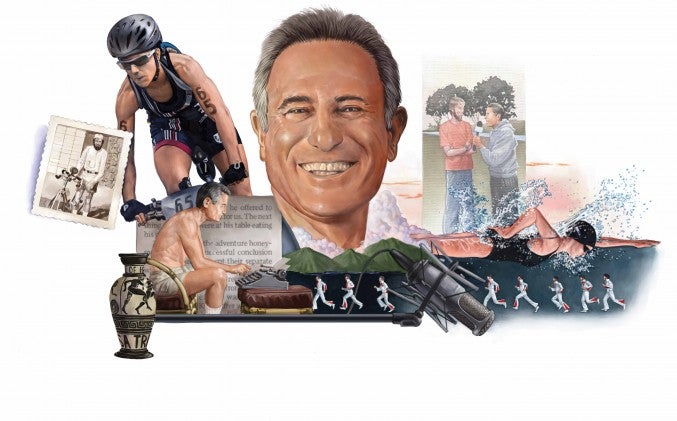Never A Bad Day: Small Sport, Big Heart

Illustration by Matt Collins.
It was early on a Sunday morning in late October about 15 years ago. Jeffrey Essakow and I, two of the founders of the Challenged Athletes Foundation, were sitting on a bench overlooking the Pacific Ocean at La Jolla Cove. In a few hours, able-bodied and challenged athletes would be arriving for a day we call the “best day in triathlon.” Oct. 20, 2013 served as the 20-year anniversary of both the San Diego Triathlon Challenge and the Challenged Athletes Foundation. The goal that first year was to help one athlete by the name of Jim MacLaren, who just might be the greatest challenged athlete of them all.
Jim had been a 300-pound offensive lineman at Yale, and in 1985 he was taking acting classes in New York City. While on his motorcycle heading to class one day, he was hit by a bus and thrown 90 feet in the air. Although his injuries were extensive (he was even pronounced dead at the accident scene), Jim lived. His left leg was amputated below the knee and he then reinvented himself as an endurance athlete and proceeded to rewrite the rules of what a challenged athlete could accomplish.
On a prosthetic leg that was prehistoric compared to what athletes use today, Jim ran a 3:16 marathon and went 10:42 at the Ironman World Championship. He wasn’t happy just to participate in these events, however. Jimmy wanted to be a factor, and he was. “My goal was to finish in the top 20 percent of any event I entered,” he says.
Eight years after his first accident, Jimmy was racing on a closed course in Orange County, Calif., when his bike was hit by a car, leaving him a quadriplegic. After the second accident, three of us—Rick Kozlowski, a race director in San Diego, Jeffrey from the Tinley Clothing Company and I—decided to create a fundraiser for Jimmy, and the entire sport of triathlon rallied to support the effort.
PHOTOS: 2013 San Diego Triathlon Challenge
I knew that Jimmy would soon need a vehicle he could drive with his hands to give him some semblance of independence and normalcy. That first year, our goal was to raise $25,000 to buy that van. We raised $49,000.
A few of Jim’s fellow amputees came that day to support Jim. They told us that health insurance covers a walking-around leg or an everyday wheelchair in case of an injury, but anything to do with sport is considered a luxury item and not covered. That’s when CAF was born. Since then we have raised north of $47 million and helped thousands of people all over the world get the equipment and support they need to stay in the game of life through sport.
On that day 15 years ago, Jeffrey and I were sitting on the bench by La Jolla Cove to go through the details of event day—things like banner placement, starting times and pre- and post-race plans.
As we sat there, a quadriplegic named Joe McCarthy rolled up next to us. Joe was injured while surfing and his first time back in the ocean after being paralyzed had been at our San Diego Triathlon Challenge the year before. He was now a top Paralympic swimmer and would be swimming the relay leg that morning. As Jeffrey and I watched, Joe removed a banana from his bag, grasped it as best he could between the knuckles of both hands, and smashed it repeatedly against the railing right in front of us. Then he used his teeth to peel the banana.
Jeffrey and I were transfixed by what we were watching, and the moment was both eerie and eye-opening at the same time. I had goose bumps, and my eyes welled up with tears.
Triathlon is special. Yes, in the scheme of things, it is a very small sport. But when it comes to changing lives for the better, for having heart, it is the biggest sport of them all.
Bob Babbitt (@bob_babbitt) is the co-founder of Competitor magazine, the co-founder of the Challenged Athletes Foundation, the host of Competitor Radio and an inductee into the Ironman Triathlon Hall of Fame and USA Triathlon Hall of Fame. To hear his interviews with more than 500 endurance legends, visit Competitorradio.com.